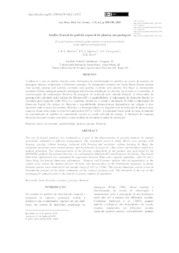Análise fractal do padrão espacial de plantas em pastagem.
Análise fractal do padrão espacial de plantas em pastagem.
Author(s): MARTINS, C. E. N.; QUADROS, F. L. F.; GARAGORRY, F. C.; ROSSI, G. E.
Summary: ABSTRACTThe use of fractal analysis was evaluated as a tool in the determination of grazing patterns in natural grasslands submitted to different managements. The treatments tested in Santa Maria were grazing with burning, grazing without burning, exclusion with burning and exclusion without burning. In Bagé, the evaluated treatments were natural pasture and introduction of ryegrass, white clover and birdsfoot trefoil in a natural grassland. The characterization of the floristic composition of the pasture was performed by the BOTANAL method. The pasture diversity was calculated by Shannon (H') and Evenness (J) indexes. The fractal dimension information was calculated by regression between H'(ε) and ε natural algorithm, with the line?s slope being the fractal dimension information. Shannon and Evenness indexes showed dependence on the sample area, where the highest floristic diversity and homogeneity of the distribution frequency of plants between species were observed in the sample range of 0.87 to 1.03m2. The fractal dimension can be a tool in determining patterns in the plant community on the reduced grazing scale. The limitation of the use of this technique for reduced scales is the need for a greater number of repetitions.Keywords: burn, diversity, evenness, grazing, shannon
Publication year: 2020
Types of publication: Journal article
Observation
Some of Embrapa's publications are published as ePub files. To read them, use or download one of the following free software options to your computer or mobile device. Android: Google Play Books; IOS: iBooks; Windows and Linux: Calibre.
Access other publications
Access the Agricultural Research Database (BDPA) to consult Embrapa's full library collection and records.
Visit Embrapa Bookstore to purchase books and other publications sold by Embrapa.

